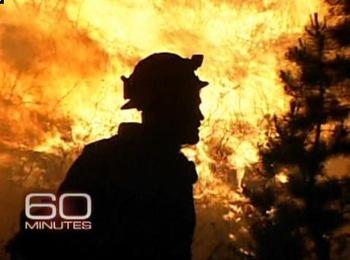Last night on the television program "60 Minutes", reporter Scott Pelley traveled into the burning forests of the West to find out why we've been seeing more intense fires in the last few years. As is said in the report, more land burned in 2006 than in any previously recorded year, and 2007 is currently second worst (with a couple months left to go before it's all over).
Video: 60 Minutes - The Age of Megafires (11:25)
What's going on? Well, it isn't just Climate Change, but that is probably the biggest culprit. Warmer temps mean fire season starts earlier and end later than in years past, forest undergrowth doesn't contain the same levels of moisture they once did, and once rare fires in alpine environments are now more commonplace.
As a friend pointed out recently in email, in many areas, an increase in winter and spring precipitation may produce increased growth of fine fuels. In the Southwest in particular, we're expecting an expansion of cheatgrass. In forested areas, trees are likely to come under increasing moisture stress and be more prone to insects and diseases.
When wildland firefighters encounter a particularly intractable fire, they often state that they don't expect the fire to be actually extinguished until winter weather arrives. With climate change constricting what we know as winter, that may take on new meaning.
The US Department of Energy's Lawrence Berkeley National Lab has stated,
In most cases, climate change would lead to dramatic increases in both the annual area burned by California wildfires and the number of potentially catastrophic fires -- doubling these losses in some regions.
These changes would occur despite deployment of fire suppression resources at the highest current levels, implying that climatic change could precipitate an increase in both fire suppression costs and economic losses due to wildfires.
The latest predictions suggest that global warming may also create conditions that intensify wildfire danger, by warming and drying out vegetation, and by stirring the winds that spread fires.
Climate change would cause fires to spread faster and burn more intensely in most vegetation types.
Faster fires are much harder to contain, and thus are more likely to expand into residential neighborhoods, incurring substantial damage to insured property.




Add comment